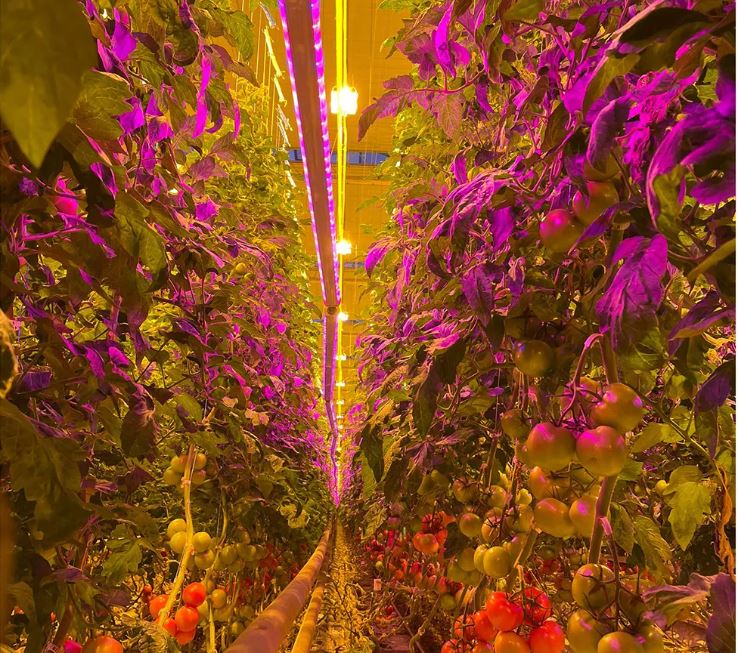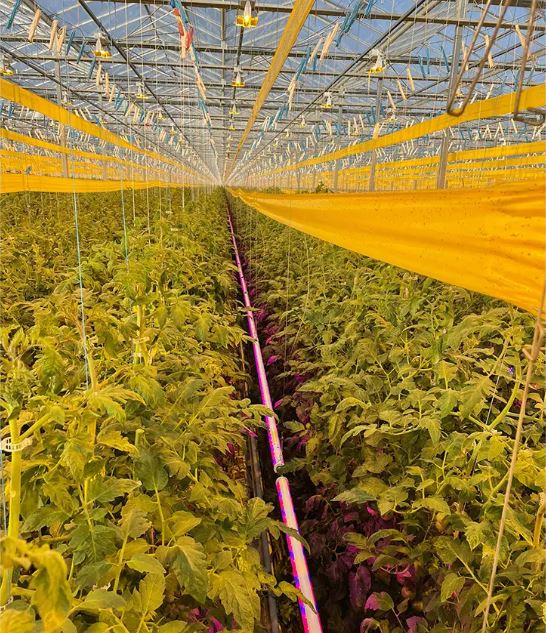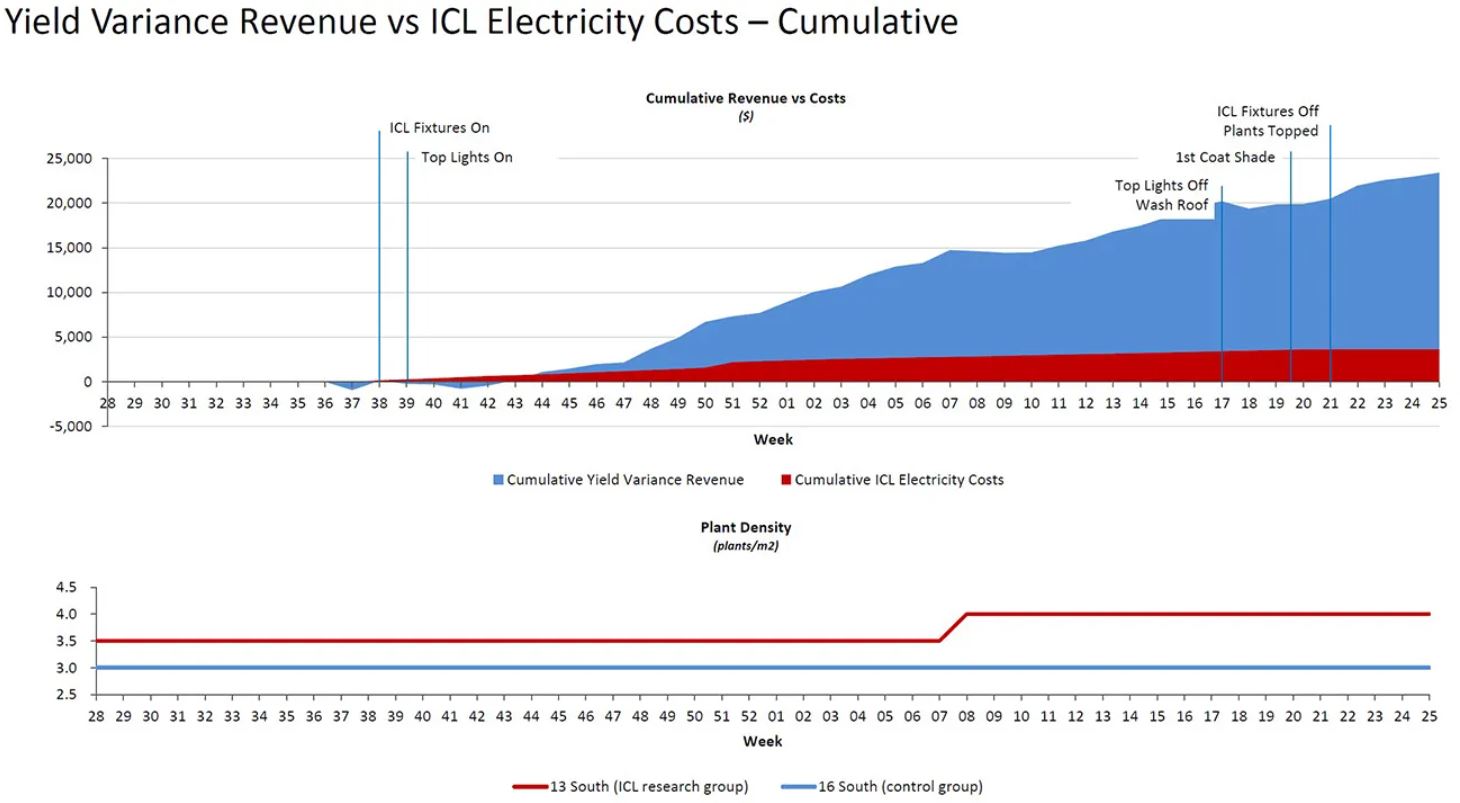
A U.S. greenhouse grower in the Midwest was able to increase its yields of ‘Macxize’ tomatoes-on-the-vine crops by 17 percent by combining intracanopy LED lighting with high pressure sodium top lighting. Photos courtesy of Hort Americas
By David Kuack
Hort Americas is partnering with a U.S. greenhouse vegetable grower to determine if intracanopy/intercanopy LED lighting can improve tomato yields with the potential to increase revenue.
A critical factor in growing greenhouse vegetables is ensuring the crops are produced in an environment that not only maximizes yields, but consistently produces predictable yields. A U.S. greenhouse tomato grower in the Midwest had installed high pressure sodium (HPS) lamps to maintain the proper top light levels year round to maintain consistent fruit production. The HPS lamps were used to provide supplemental light from November to March.
The tomato greenhouses are equipped with environmental sensors that measure light levels outside the greenhouses, at the top of the plant canopy and in the lower one-third of the canopy. Sensors also collect data on the substrate moisture level, relative humidity, carbon dioxide level, temperatures inside and outside the greenhouses and airflow rates. A Priva environmental control system collects the data enabling the grower to evaluate the data in order to manipulate the crops and environment to maximize fruit yields.
In addition to manipulating the environment, different plant dimensions are measured, including stem diameter and length, leaf length, number of tomato fruit clusters, and the speed at which plants flower. Using the data collected by these sensors, the grower can measure changes to the plants and establish a basis for steering the tomato crop. Collecting this data and analyzing it is particularly important when growers are looking to implement new technology that can improve plant growth and/or crop yields.
Study looks at effects of intracanopy/intercanopy lighting
Because of the plant canopy, the amount of top light that reaches the interior of the plants, particularly vining crops, can be inconsistent and uneven. Intracanopy/intercanopy lighting, which uses LED grow lights to provide supplemental light within the crop canopy, has been shown to be successful in increasing yields with both ornamental (fresh cut roses) and vining vegetable crops (peppers and cucumbers).

Installing Arize LED grow lights to provide supplemental intracanopy light allowed for tomato plants to be spaced at a higher density of 3.5 plants per square meter compared to three plants per square meter for the control plants.
Installing grow lights within the plant canopy of greenhouse ornamental and vegetable crops has been referred to as intracanopy lighting, intercanopy lighting and interlighting. The terms have been used interchangeably by researchers and grow light fixture manufacturers and distributors. Regardless of the term used, the concept is the same—to provide supplemental light to the lower portions of the plants to increase photosynthesis with the potential to increase flower and fruit yields.
In the second year of their partnership to increase tomato fruit yields, the tomato grower set up a research study with Hort Americas to determine if intracanopy LED lighting could improve yields of ‘Macxize’ tomatoes-on-the-vine crops.
Arize Integral LED grow lights were installed within the plant canopy consisting of four growing rows of a 9,817-square-foot greenhouse section. A similar sized section within the same greenhouse was used as a control and was not equipped with the intracanopy LED lights. ‘Macxize’ tomatoes were grown in both greenhouse sections.
Increased light, increased plant density
The Arize LED grow lights were located 6 feet above the substrate level with 48 light fixtures installed in each row. The intracanopy LED lights allowed for the tomato plants to be spaced at a higher density of 3.5 plants per square meter compared to three plants per square meter for the control plants. Plants in the control section were planted at the lower density to maintain the same fruit size in this section from week to week. The intracanopy lights were operated from Week 38, 2022, through Week 21, 2023, for 17 hours per day from 6 a.m. to 11 p.m.
Increased yields, potential increased revenue
The grower harvested a total yield of 89,377 kilograms of tomatoes in the intracanopy-lighted section compared to 76,376 kilograms harvested in the control section over a 41-week harvest period. In the intracanopy-lighted section fruit yield was 98 kilograms per square meter, which was 17 percent more than the control section’s 83.7 kilogram per square meter. Average fruit size was slightly smaller (0.24 percent) for the intracanopy-lighted plants compared to the control plants.

The intracanopy LED lights were operated from Week 38, 2022, through Week 21, 2023, for 17 hours per day from 6 a.m. to 11 p.m. The intracanopy-lighted plants produced a fruit yield of 98 kilograms per square meter, which was 17 percent more than the control section’s 83.7 kilogram per square meter.
Assuming a selling price of $1.80 per kilogram, tomatoes harvested from the intracanopy section generated $160,879 in revenue. This is $23,404 in additional revenue compared to $137,476 from the control section.
The total cost of electricity to power the intracanopy lights during the 41-week study period was $3,621. Subtracting the electricity cost from the additional revenue generated by the intracanopy-lighted section, resulted in $19,783 additional gross income, or 14.4 percent more than the control section.

Subtracting the electricity cost ($3,621) to power the intracanopy LED lights from the additional revenue ($23,404) generated by the intracanopy-lighted section, resulted in an additional $19,783 gross income, 14.4 percent more than the control section.
TrendForce 2023 Global LED Lighting Market Analysis
Publication dates: February 10, 2023; July 31, 2023
Language: Traditional Chinese/English
File format: PDF and EXCEL
Number of pages: 100 (in each publication)
|
If you would like to know more details , please contact:
|





 CN
TW
EN
CN
TW
EN





